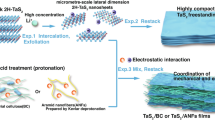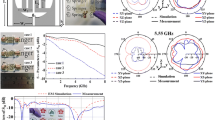Abstract
Transient electronic is an emerging field that designed electronic devices can be fleetly and partially (or completely) degraded when transiency is triggered. Here, a class of PVA-based degradable composite film was synthesized, whose physical properties allow it to be used as substrate material for transient electronic devices. We found the dielectric properties and dissolution rate of the composite film can be tuned by controlling the TiO2 nanoparticle addition. Based on the as-synthesized PVA/TiO2 composite film, patch antennas were further designed and fabricated. The antennas were found to possess excellent radiation performances at a frequency of 2.5 GHz. Most importantly, the antennas could be physically degraded within 1 h when immersed in pure water. This study shows that the PVA-based film is a good candidate substrate or supporting material for transient electronics. In addition, the design and manufacture methods reported here provide a reference for other transient devices with complex structure and function.









Similar content being viewed by others
References
Hwang SW, Tao H, Kim DH et al (2012) A physically transient form of silicon electronics. Science 337:1640–1644. doi:10.1126/science.1226325
Kim DH, Kim YS, Amsden J et al (2009) Silicon electronics on silk as a path to bioresorbable, implantable devices. Appl Phys Lett 95:133701–133703. doi:10.1063/1.3238552
Berggren M, Richter-Dahlfors A (2007) Organic bioelectronics. Adv Mater 19:3201–3213. doi:10.1002/adma.200700419
Kang SK, Murphy RKJ, Hwang SW et al (2016) Bioresorbable silicon electronic sensors for the brain. Nature 530:71–76. doi:10.1038/nature16492
Fu KK, Wang ZY, Dai JQ, Carter M, Hu LB (2016) Transient electronics: materials and devices. Chem Mater 28:3527–3539. doi:10.1021/acs.chemmater.5b04931
Gao Y, Zhang Y, Wang X et al (2017) Moisture-triggered physically transient electronics. Sci Adv 3:e.1701222–e.1701229. doi:10.1126/sciadv.1701222
Gao Y, Sim K, Yan X, Jiang J, Xie JW, Yu CJ (2017) Thermally triggered mechanically destructive electronics based on electrospun poly(epsilon-caprolactone) nanofibrous polymer films. Sci Rep 7:947–955. doi:10.1038/s41598-017-01026-6
Yin L, Huang X, Xu HX et al (2014) Materials, designs, and operational characteristics for fully biodegradable primary batteries. Adv Mater 26:3879–3884. doi:10.1002/adma.201306304
Dong ZF, Wang Q, Du YM (2006) Alginate/gelatin blend films and their properties for drug controlled release. J Membr Sci 280:37–44. doi:10.1016/j.memsci.2006.01.002
Acar H, Cinar S, Thunga M, Kessler MR, Hashemi N, Montazami R (2014) Study of physically transient insulating materials as a potential platform for transient electronics and bioelectronics. Adv Funct Mater 24:4135–4143. doi:10.1002/adfm.201304186
Hwang SW, Song JK, Huang X et al (2014) High-performance biodegradable/transient electronics on biodegradable polymers. Adv Mater 26:3905–3911. doi:10.1002/adma.201306050
Hernandez HL, Kang SK, Lee OP et al (2014) Triggered transience of metastable poly(phthalaldehyde) for transient electronics. Adv Mater 26:7637–7642. doi:10.1002/adma.201403045
Jain RA (2000) The manufacturing techniques of various drug loaded biodegradable poly(lactide-co-glycolide) (PLGA) devices. Biomaterials 21:2475–2490. doi:10.1016/s0142-9612(00)00115-0
Grayson ACR, Voskerician G, Lynn A, Anderson JM, Cima MJ, Langer R (2004) Differential degradation rates in vivo and in vitro of biocompatible poly(lactic acid) and poly(glycolic acid) homo- and co-polymers for a polymeric drug delivery microchip. J Biomater Sci Polym Ed 15:1281–1304. doi:10.1163/1568562041959991
Sim K, Wang X, Li YH et al (2017) Destructive electronics from electrochemical-mechanically triggered chemical dissolution. J Micromech Microeng 27:065010–065018. doi:10.1088/1361-6439/aa682f
Park CW, Kang SK, Hernandez HL et al (2015) Thermally triggered degradation of transient electronic devices. Adv Mater 27:3783–3788. doi:10.1002/adma.201501180
Wang XQ, Yucel T, Lu Q, Hu X, Kaplan DL (2010) Silk nanospheres and microspheres from silk/PVA blend films for drug delivery. Biomaterials 31:1025–1035. doi:10.1016/j.biomaterials.2009.11.002
Yang DZ, Li YN, Nie J (2007) Preparation of gelatin/PVA nanofibers and their potential application in controlled release of drugs. Carbohydr Polym 69:538–543. doi:10.1016/j.carbpol.2007.01.008
Liu TY, Hu SH, Liu KH, Liu DM, Chen SY (2008) Study on controlled drug permeation of magnetic-sensitive ferrogels: effect of Fe3O4 and PVA. J Control Release 126:228–236. doi:10.1016/j.jconrel.2007.12.006
Frosini V, Butta E, Calamia M (1967) Dielectric behavior of some polar high polymers at ultra-high frequencies (microwaves). J Appl Polym Sci 11:527–551
Yang CC (2007) Synthesis and characterization of the cross-linked PVA/TiO2 composite polymer membrane for alkaline DMFC. J Membr Sci 288:51–60. doi:10.1016/j.memsci.2006.10.048
Rao JK, Raizada A, Ganguly D, Mankad MM, Satayanarayana SV, Madhu GM (2015) Investigation of structural and electrical properties of novel CuO–PVA nanocomposite films. J Mater Sci 50:7064–7074. doi:10.1007/s10853-015-9261-0
Wu TM, Cheng JC, Yan MC (2003) Crystallization and thermoelectric behavior of conductive-filler-filled poly(1-caprolactone)/poly(vinyl butyral)/montmorillonite nanocomposites. Polymer 44:2553–2562. doi:10.1016/s0032-3861(03)00106-x
Andrade GI, Barbosa-Stancioli EF, Mansur AAP, Vasconcelos WL, Mansur HS (2008) Small-angle X-ray scattering and FTIR characterization of nanostructured poly (vinyl alcohol)/silicate hybrids for immunoassay applications. J Mater Sci 43:450–463. doi:10.1007/s10853-007-1953-7
Shehap AM, Akil DS (2016) Structural and optical properties of TiO2 nanoparticles/PVA for different composites thin films. Int J Nanoelectron Mater 9:17–36
Skipetrov SE (1999) Effective dielectric function of a random medium. Phys Rev B 60:12705–12709. doi:10.1103/PhysRevB.60.12705
Maex K, Baklanov MR, Shamiryan D, Iacopi F, Brongersma SH, Yanovitskaya ZS (2003) Low dielectric constant materials for microelectronics. J Appl Phys 93:8793–8841. doi:10.1063/1.1567460
Choudhary S, Sengwa RJ (2017) Anomalous behavior of the dielectric and electrical properties of polymeric nanodielectric poly(vinyl alcohol)–titanium dioxide films. J Appl Polym Sci 134::44568–44579. doi:10.1002/app.44568
Song LN, Myers AC, Adams JJ, Zhu Y (2014) Stretchable and reversibly deformable radio frequency antennas based on silver nanowires. ACS Appl Mater Interfaces 6:4248–4253. doi:10.1021/am405972e
Acknowledgements
This work was financially supported by the National R&D Program of China under No. 2017YFA0207400, National Key Research and Development Plan (No. 2016YFA0300801), National Natural Science Foundation of China under Nos. 51502033, 61571079, and International Cooperation Projects under Grant No. 2015DFR50870.
Author information
Authors and Affiliations
Corresponding authors
Electronic supplementary material
Below is the link to the electronic supplementary material.
Rights and permissions
About this article
Cite this article
Xu, F., Zhang, H., Jin, L. et al. Controllably degradable transient electronic antennas based on water-soluble PVA/TiO2 films. J Mater Sci 53, 2638–2647 (2018). https://doi.org/10.1007/s10853-017-1721-2
Received:
Accepted:
Published:
Issue Date:
DOI: https://doi.org/10.1007/s10853-017-1721-2




